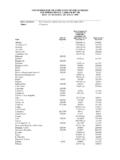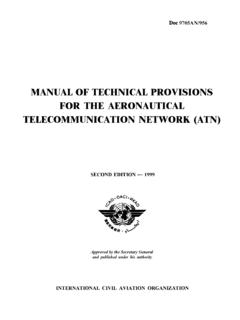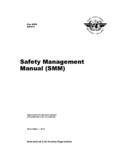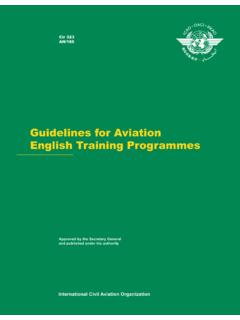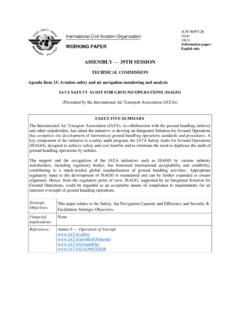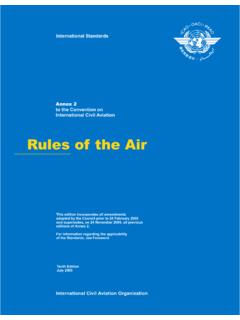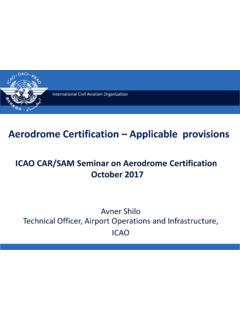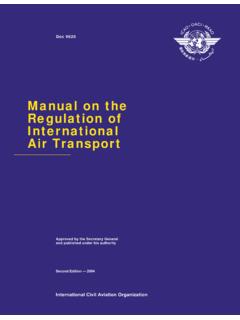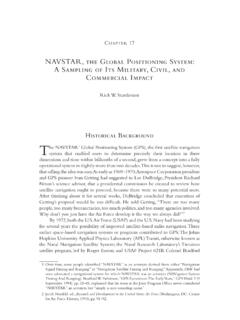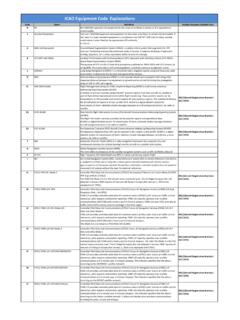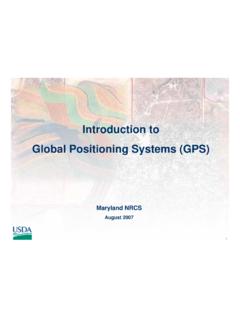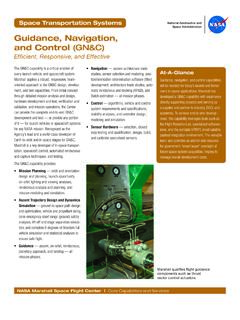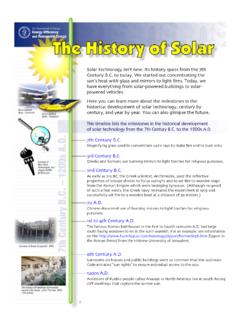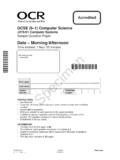Transcription of Global Navigation Satellite System (GNSS) Manual
1 International Civil Aviation OrganizationApproved by the Secretary Generaland published under his authorityGlobal NavigationSatellite System ( gnss ) ManualFirst Edition 2005 Doc 9849AN/457 AMENDMENTSThe issue of amendments is announced regularly in the ICAO Journal and in themonthly Supplement to the Catalogue of ICAO Publications and Audio-visualTraining Aids, which holders of this publication should consult. The space belowis provided to keep a record of such OF AMENDMENTS AND by(ii) (iii) FOREWORD The Global Air Navigation Plan for CNS/ATM Systems (Doc 9750) recognizes the Global Navigation Satellite System ( gnss ) as a key element of the Communications, Navigation , and Surveillance/Air Traffic Management (CNS/ATM) systems as well as a foundation upon which States can deliver improved aeronautical Navigation services.
2 The Standards and Recommended Practices (SARPs) for gnss were developed by the Global Navigation Satellite System Panel and introduced as part of Amendment 76 to Annex 10 to the Convention on International Civil Aviation Aeronautical Telecommunications, Volume I (Radio Navigation Aids) in 2001. The guidance information and material in Attachment D to Annex 10, Volume I provides extensive guidance on the technical aspects and the application of gnss SARPs. The primary purpose of this Manual is to provide information on the implementation aspects of gnss in order to assist States in the introduction of gnss operations. The Manual is therefore aimed at air Navigation service providers responsible for fielding and operating gnss elements, and at regulatory agencies responsible for approving the use of gnss for flight operations.
3 Additionally, it provides gnss information to aircraft operators and manufacturers. This Manual is to be used in conjunction with the relevant provisions in Annex 10, Volume I. Comments on this Manual would be appreciated from all parties involved in the development and implementation of gnss . These comments should be addressed to: The Secretary General International Civil Aviation Organization 999 University Street Montr al, Quebec H3C 5H7 Canada (v) TABLE OF CONTENTS Page Chapter 1. 1-1 General .. 1-1 gnss elements .. 1-1 Operational advantages of gnss .. 1-2 gnss limitations and associated issues .. 1-2 The gnss planning process .. 1-3 Chapter 2. Overview of gnss -based Operations .. 2-1 General .. 2-1 Operations using aircraft-based augmentation System (ABAS).
4 2-1 Operations using Satellite -based augmentation System (SBAS) .. 2-3 Operations using ground-based augmentation System (GBAS).. 2-4 Chapter 3. gnss System 3-1 General .. 3-1 Existing Satellite -based Navigation systems .. 3-1 Augmentation 3-3 gnss avionics .. 3-7 Chapter 4. Providing Services with 4-1 General .. 4-1 Performance characteristics .. 4-1 Operational potential of gnss augmentation systems .. 4-3 Chapter 5. gnss Implementation .. 5-1 General .. 5-1 Planning and organization .. 5-1 Procedures development .. 5-4 Airspace 5-6 ATC 5-7 Aeronautical information services .. 5-8 Certification and operational approvals .. 5-11 gnss 5-15 Transition 5-19 (vi) Global Navigation Satellite System ( gnss ) Manual Page Chapter 6.
5 Evolution of the gnss .. 6-1 General .. 6-1 gnss requirements to support other applications .. 6-2 Security 6-2 gnss evolution .. 6-2 Protection dates .. 6-5 Appendix A. A-1 Appendix B. References .. B-1 Appendix C. gnss Implementation Team Example of Terms of Reference .. C-1 Appendix D. Examples of gnss Vulnerability Assessment for Existing D-1 _____ 1-1 Chapter 1 INTRODUCTION GENERAL This Manual describes the concepts of operation that uses the core Satellite constellations ( Global Positioning System (GPS) and Global Navigation Satellite System (GLONASS)) and augmentation systems. It includes a basic explanation of Satellite Navigation technology including Satellite systems, augmentations and avionics. It discusses the services provided by Global Navigation Satellite System ( gnss ) and describes the implementation considerations that will assist States plan for the orderly introduction of service based on gnss guidance.
6 Finally, it outlines future prospects for the evolution of gnss . gnss ELEMENTS The two core Satellite constellations are the GPS and the GLONASS, provided by the United States of America and the Russian Federation, respectively, in accordance with the Standards and Recommended Practices (SARPs). These two systems provide independent capabilities and can be used in combination with future core Satellite constellations and augmentation systems. States authorizing gnss operations remain however responsible for determining if gnss meets Annex 10 Aeronautical Telecommunications performance requirements in their airspace and for notifying users when performance does not meet these requirements. The satellites in the core Satellite constellations broadcast a timing signal and a data message that includes their orbital parameters (ephemeris data).
7 Aircraft gnss receivers use these signals to calculate their range from each Satellite in view, and then to calculate three-dimensional position and time. The gnss receiver consists of an antenna and a processor which computes position, time and, possibly, other information depending on the application. Measurements from a minimum of four satellites are required to establish three-dimensional position and time. Accuracy is dependent on the precision of the measurements from the satellites and the relative positions (geometry) of the satellites used. The existing core Satellite constellations alone however do not meet strict aviation requirements. To meet the operational requirements for various phases of flight, the core Satellite constellations require augmentation in the form of aircraft-based augmentation System (ABAS), Satellite -based augmentation System (SBAS) and/or ground-based augmentation System (GBAS).
8 ABAS relies on avionics processing techniques or avionics integration to meet aviation requirements. The other two augmentations use ground monitoring stations to verify the validity of Satellite signals and calculate corrections to enhance accuracy. SBAS delivers this information via a geostationary earth orbit (GEO) Satellite , while GBAS uses a VHF data broadcast (VDB) from a ground station. 1-2 Global Navigation Satellite System ( gnss ) Manual OPERATIONAL ADVANTAGES OF gnss Being Global in scope, gnss is fundamentally different from traditional navigational aids (NAVAIDs). It has the potential to support all phases of flight by providing seamless Global Navigation guidance. This could eliminate the need for a variety of ground and airborne systems that were designed to meet specific requirements for certain phases of flight.
9 The first approvals to use gnss came in 1993, supporting en-route (domestic and oceanic), terminal and non-precision approach (NPA) operations. The approvals, based on ABAS, came with operational restrictions but delivered significant benefits to aircraft operators. gnss provides accurate guidance in remote and oceanic areas where it is impractical or too costly or impossible to provide reliable and accurate traditional NAVAID guidance. Many States employ gnss to deliver improved service to aircraft operators while at the same time avoiding the cost of fielding traditional NAVAIDs. Even in areas well served by traditional NAVAIDs, gnss supports area Navigation operations, allowing aircraft to follow more efficient flight paths. gnss brings this capability within the economic reach of all aircraft operators.
10 This allows States to design en-route and terminal airspace for maximum capacity and minimum delays. The availability of accurate gnss -based guidance on departure supports efficient noise abatement procedures. It allows greater flexibility in routings, where terrain is a restricting factor, providing the possibility of lower climb gradients and higher payloads. gnss can improve airport usability, through lower minima, without the need to install a NAVAID at the airport. gnss may support approach procedure with vertical guidance (APV) on all runways, with proper consideration of aerodrome standards for physical characteristics, marking and lighting (see ). When a landing threshold is displaced, the flexibility inherent in gnss can allow continued operations with vertical guidance to the new threshold. gnss may also be used to support surface operations.
